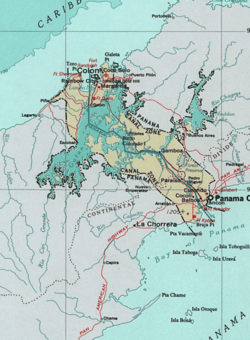Panama Canal Zone
The Panama Canal Zone was a 553 square mile (1,432 km²) territory inside of Panama, consisting of the Panama Canal and an area generally extending 5 miles (8.1 km) on each side of the centerline (but excluding Panama City and Colón, which otherwise would have fallen in part within the limits of the Canal Zone.) Its border spanned two of Panama's provinces and was created on November 18, 1903 with the signing of the Hay-Bunau-Varilla Treaty.
From 1903 to 1979 the territory was controlled by the United States of America, which had built and financed the canal's construction. From 1979 to 1999 the canal itself was under joint U.S.-Panamanian control. In 1977 the Torrijos-Carter Treaties established the neutrality of the canal. [1]
During U.S. control of the Canal Zone, the territory, apart from the canal itself, was used mainly for military purposes; however, approximately 3,000 American civilians (called "Zonians") made up the core of permanent residents. U.S. military usage ended when the zone returned to Panamanian control. It is now a tourist destination of sorts, especially for visiting cruise ships.
The Panama Canal Zone was the birthplace of John McCain, Richard Prince, and Rod Carew.
Panama Canal Company
The canal was operated by the Panama Canal Company (after 1979, it was the Panama Canal Commission). The Canal Zone Government controlled the Canal Zone; kind of a cross between a colonial company enclave and a socialist government. Everyone worked for the Company or the Government in one form or another. There were no independent stores, goods were brought in and sold at a series of stores run by the company such as a commissary, house wares, and so on. The Canal Zone had its own police force, courts and judges. The head of the company was also the Governor of the Canal Zone. No one owned houses; instead they rented houses that were assigned, primarily based on seniority in the zone. When someone would leave for one reason or another, the house would be listed and employees could apply for it. The utility companies were also run by the company.
Townships

The Canal Zone was generally divided into two sections, the Pacific Side and the Atlantic Side, with Lake Gatun separating them.
A partial list of Canal Zone townships:
- Pacific Side
- Amador - on the coast, partly built on land extended into the sea using excavation materials from the canal construction
- Ancon - built on the lower slopes of Ancon Hill, adjacent to Panama City. Also home to Gorgas Hospital.
- Balboa - Administrative capital, as well as location of the harbor and primary Pacific Side high school
- Balboa Heights
- Cardenas - as the Canal Zone was gradually handed over to Paanamanian control, Cardenas was one of the last Zonian holdouts.
- Diablo
- Diablo Heights
- Gamboa - headquarters of dredging division, located on Lake Gatun. Many new arrivals to Canal Zone were assigned here.
- La Boca - home of the Panama Canal College
- Los Rios
- Paraiso
- Pedro Miguel
- Red Tank - was abandoned and allowed to be overgrown sometime around 1950.
- Atlantic Side
- Coco Solo - main hospital
- Cristobal - main Atlantic Side high school
- Gatun
- Margarita
- Rainbow City
Postage stamps

The Canal Zone issued its own postage stamps beginning in 1904. Initially they were the current stamps of Panama or (less often) the US, overprinted with "CANAL ZONE" in various ways. Philatelists have identified over 100 varieties, some of them quite rare (and counterfeited). The last of these overprints were issued in 1939.
In 1928, the Zone issued a definitive series inscribed "CANAL ZONE POSTAGE" depicting various persons involved in the construction of the canal, as well as a 5 c value showing the Gaillard Cut. A series of 16 stamps in 1939 commemorating the 25th anniversary of the canal's completion showed "before" and "after" views of various points along the canal. Thereafter stamps appeared at an average rate of about two per year, with a commemorative set in some years and no stamps in others. The inscriptions were changed to just "CANAL ZONE" in the 1960s. This paralleled the abandonment of the word "POSTAGE" on many United States stamps, as the United States ceased to issue revenue stamps.
The most famous Canal Zone stamp was the four cent stamp (Scott #157, error stamp #157a) issued on October 12, 1962 for the opening of the Thatcher Ferry Bridge (now the Bridge of the Americas), the first elevated bridge connecting the two sides of the Canal. One pane of fifty stamps was released without the silver ink used to depict the Bridge. Upon learning of this, Canal Zone postal officials proposed to release a large quantity of intentional errors, to destroy the value of the errors. This would have paralleled what was done at almost the same time for the U.S. four cent stamp showing Dag Hammerskjold--some stamps had been issued with an inverted background, and to destroy their value, the United States Post Office Department, within a month of the original release, issued millions more. Publicity and a lawsuit by stamp dealer H.E. Harris, who was in possession of some of the errors, and claimed that the new release would effectively destroy their value prevented the release of the Canal Zone intentional errors.[2]
The final years of the Canal Zone saw few stamps issued--those that were issued were mainly for new first-class postal rates (the first-class rates paralleled those of the United States) The last stamp (fifteen cents) of the Zone was issued on October 25, 1978, and depicted one of the towing locomotives and a ship in a lock. Thereafter Panama took over the administration of postal service, and after a brief transition period, Canal Zone stamps became invalid.
